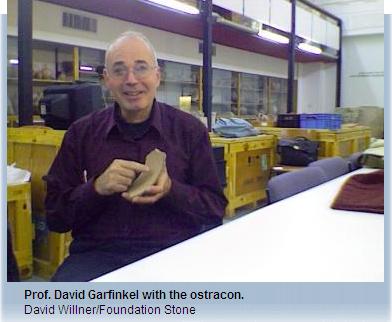Only in Israel - Oldest Hebrew Text
|
Archaeologist says he found oldest Hebrew writing Associated Press October 31, 2008 Hirbet Qeiyafa, Israel (AP) - An Israeli archaeologist has discovered what he believes is the oldest known Hebrew inscription on a 3,000-year-old pottery shard - a find that suggests Biblical accounts of the ancient Israelite kingdom of David could have been based on written texts. 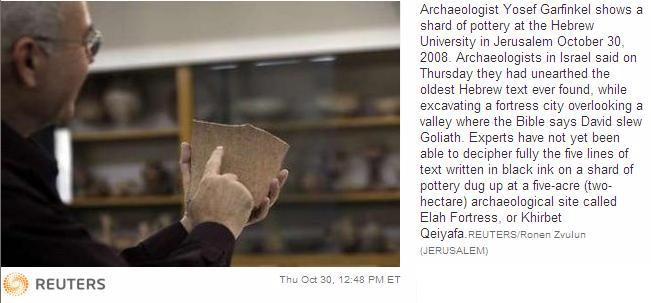
A teenage volunteer discovered the curved shard bearing five lines of faded characters in July in the ruins of an ancient town on a hilltop south of Jerusalem. Yossi Garfinkel, the Israeli archaeologist leading the excavations at Hirbet Qeiyafa, released his conclusions about the writing Thursday after months of study. He said the relic is strong evidence that the ancient Israelites were literate and could chronicle events centuries before the Bible was written. This could suggest that some of the Bible's accounts were based on written records as well as oral traditions - adding credence to arguments that the Biblical account of history is more than myth. 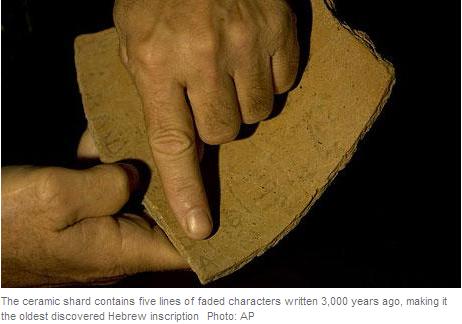
The shard was found near the stairs and stone washtub of an excavated home. It was later discovered to bear characters known as proto-Canaanite, a precursor of the Hebrew alphabet. The Israelites were not the only ones using the proto-Canaanite characters, and other scholars suggest it is difficult - perhaps impossible - to conclude the text is Hebrew. However, Garfinkel based his identification on a three-letter verb from the inscription meaning "to do," a word he said existed only in Hebrew. "That leads us to believe that this is Hebrew, and that this is the oldest Hebrew inscription that has been found," he said. Hirbet Qeiyafa sits near the modern Israeli city of Beit Shemesh in the Judean foothills, an area that was once the frontier between the hill-dwelling Israelites and their enemies, the coastal Philistines. The site overlooks the Elah Valley, said to be the scene of the slingshot showdown between David and the Philistine giant Goliath, and near the ruins of Goliath's hometown in the Philistine metropolis of Gath. 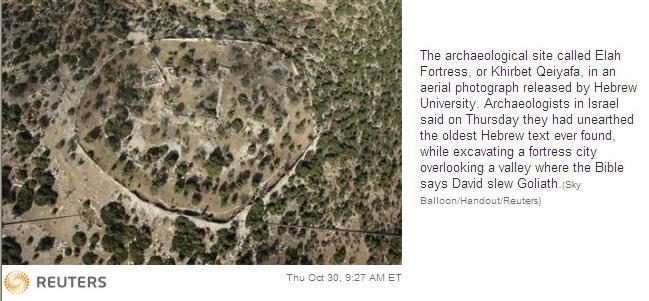 Carbon-14 analysis of burnt olive pits found in the same layer of the site as the pottery shard helped archaeologists date it to between 1,000 and 975 B.C., the same time as the Biblical golden age of King David's rule in Jerusalem. Archaeology has turned up only scant finds from David's time in the early 10th century B.C., leading some scholars to argue the Bible's account of the period inflates the importance of him and his kingdom. Some have even suggested his kingdom may not have existed at all. But the fortified settlement where the writing was found contains indications that a powerful Israelite kingdom existed near Jerusalem in David's time, says Garfinkel. If his claim is borne out, it would bolster the case for the Bible's accuracy by indicating the Israelites could record events as they happened, transmitting the history that was recorded in the Old Testament several hundred years later. Modern Zionism has traditionally seen archaeology as a way of strengthening the Jewish claim to Israel and regarded David's kingdom as the glorious ancestor of the new Jewish state. As a result, finding evidence of his rule has importance beyond its interest to scholars. The script, which Garfinkel suggests might be part of a letter, predates the next significant Hebrew inscription by between 100 and 200 years. History's best-known Hebrew texts, the Dead Sea scrolls, were penned on parchment beginning 850 years later. The shard is now kept in a university safe while philologists translate it, a task expected to take months. But several words have already been tentatively identified, including "judge," "slave" and "king." The inscription was shown to other scholars at a peer presentation of the findings. Some scholars are hesitant to embrace Garfinkel's interpretation, and his findings are already being wielded in the ongoing debate over whether the Bible - written hundreds of years after many of its events are supposed to have occurred - is more fact or legend. But the find is certain, at the very least, to prove useful in understanding the development of language and ancient alphabets. Other prominent Biblical archaeologists warned against jumping to conclusions. Hebrew University archaeologist Amihai Mazar said the inscription is "very important," but suggested that calling the text Hebrew might be going too far. "The differentiation between the scripts, and between the languages themselves in that period, remains unclear," he said. If the inscription is Hebrew, it would connect the Hirbet Qeiyafa settlement to the Israelites and make the text "one of the most important texts, without a doubt, in the corpus of Hebrew inscriptions," said Aren Maier, a Bar Ilan University archaeologist. While the site is likely to add another "building block" to the historical record, archaeologist Israel Finkelstein of Tel Aviv University said the claims about it went beyond the strict boundaries of science. Finkelstein, who has not visited the dig but attended a presentation of the findings, warned against what he said was a "revival in the belief that what's written in the Bible is accurate like a newspaper." CBS News YouTube Video - 3,000 Year-Old Text Found Yediot Achronot Hebrew article (jpg image) |
|
Oldest Hebrew Text Discovered at King David's Border Fortress http://www.israelnationalnews.com/News/News.aspx/128174 October 31, 2008 (IsraelNN.com) Archaeologists have discovered what they say is the oldest Hebrew text ever found, at a site they believe was King David's front line fortress in the war against the people of Pleshet, also known as the Philistines. The site overlooks the Elah Valley, where the young David slew Goliath, the Philistine giant, with a well-aimed shot from a sling. The text is written in ink on a pottery shard (ostracon). It is made up of five lines of text in Proto-Canaanite characters separated by lines. The discovery, by archaeologists Prof. Yossi Garfinkel and Sa'ar Ganor of Hebrew University, is being hailed as one of the most important finds in Israel since the Dead Sea Scrolls.
Carbon-14 dates to King David Carbon-14 dating as well as chemical analysis of the pottery found at the site shows conclusively that it dates from between 1,000 and 975 B.C. the time of King David's reign. David who wrote the Psalms, unified the tribes of Israel and made Jerusalem the capital of the Israeli nation is considered to be Israel's greatest King, whose reign ushered in the period in which the First Temple was built. The writing therefore predates the Dead Sea Scrolls by about 1,000 years.
'David's ruins'
Also known as the Ela Fortress because of its location at the Elah Valley near Beit Shemesh, archaeologists believe the fortress controlled a strategic point overlooking the main route connecting Pleshet and the Judean lowland with the mountainous region and the central cities of Jerusalem and Hevron. The ancient point of settlement covers more than four acres and is surrounded by a 700 meter long wall. Archaeologists believe that 200,000 tons of rock were mined in order to build it. The wall contains a massive and ornate gate built from hewn rock. 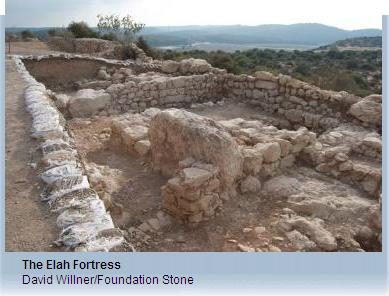
Stoned in the head The Elah Valley is the site at which Jewish and Philistine armies faced each other in one of the most glorious battles ever: the fateful victory in which David killed Goliath with a stone to the forehead. The Bible describes the location (in 1 Samuel, 17:2-3) thus: And Saul and the men of Israel were gathered together, and pitched by the valley of Elah, and set the battle in array against the Philistines. And the Philistines stood on a mountain on the one side, and Israel stood on a mountain on the other side: and there was a valley between them. The digs at the spot have been underwritten by the Berman Center Biblical Archeology Hebrew University, the Brennan Foundation and Corner Stone, which is turning the site into an educational attraction and invites the public to participate in the digs. |
 Only in Israel Index
Only in Israel Index

 JR Topics
JR Topics

 Life in Israel Articles
Life in Israel Articles

Return to JR Home
